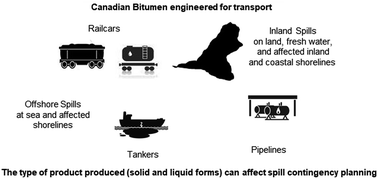Canadian bitumen is engineered for transport, but the type of product produced can affect spill contingency planning
Abstract
Canadian bitumen is too viscous to transport by rail and pipeline to markets. One approach to solve this viscosity issue is to dilute the bitumen with a thinning agent to meet transport specifications, but the addition of diluent underutilizes pipeline capacity and increases production cost. A second approach involves the partial refinement of bitumen to produce synthetic crude, which better utilizes pipeline capacity; however, capital and operational costs are high. A third alternative is a new technology that involves wrapping bitumen in a polymer layer to form a solid “puck” termed Canapux, but transportation of this product to coastal ports is limited to rail. Also, greenhouse gas emissions are greater when oil is transported by rail rather than pipeline. In the end, a variety of bitumen products will be transported in Canada, but not all of these products will respond to remediation equally when spilled. In order to ensure effective spill contingency planning, we recommend that engineered bitumen products have physical properties that are resilient to change, within the range of typical response times, after a spill.



 Please wait while we load your content...
Please wait while we load your content...